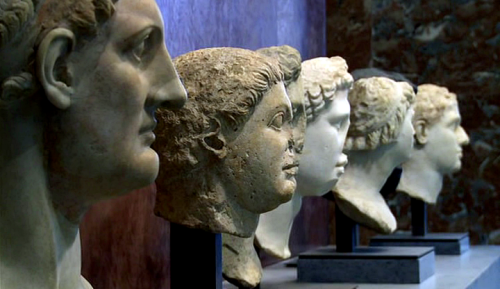#hellenistic period
On the Greatness of Homer
Anthologia Palatina 9.24 = Leonidas of Tarentum (320-260 BCE)
The fiery sun, whirling its axis,
Dulls the stars and the moon’s holy circles;
Just so Homer has plunged into night
All the songsmiths in a mass,
Holding high the Muses’ brightest light.
ἄστρα μὲν ἠμαύρωσε καὶ ἱερὰ κύκλα σελήνης
ἄξονα δινήσας ἔμπυρος ἠέλιος:
ὑμνοπόλους δ᾽ ἀγεληδὸν ἀπημάλδυνεν Ὅμηρος,
λαμπρότατον Μουσῶν φέγγος ἀνασχόμενος.

Homer, Girolamo Troppa, between 1665 and 1668
Death of a Bird-Catcher
Anthologia Palatina 7.171 = Mnasalces of Sicyon (3rd cent. BCE)
Here, too, the sacred bird will rest his swift wing,
Perched atop this sweet plane-tree:
For Poemandrus the Melian has died – he comes no longer
After smearing his fowling-twigs with bird-lime.
Ἀμπαύσει καὶ τῇδε θοὸν πτερὸν ἱερὸς ὄρνις,
τᾶσδ᾽ ὑπὲρ ἁδείας ἑζόμενος πλατάνου:
ὤλετο γὰρ Ποίμανδρος ὁ Μάλιος, οὐδ᾽ ἔτι νεῖται
ἰξὸν ἐπ᾽ ἀγρευταῖς χευάμενος καλάμοις.

The Bird-Catchers, François Boucher, 1748
Today, I’ll be going back to the Hellenistic Period, to the Hasmonean dynasty of Judea. The recipe in question is a simple honeyed-hens, recorded by Seleucid accounts of a feast held by one of the ruling elite. Though the original recipe refers to it plainly as chicken with honey, I’m going to be recreating it today based on our knowledge of contemporary dining habits!
In any case, let’s now take a look at the World That Was! Follow along with my YouTube video above!
Ingredients
4 chicken thighs
salt (to taste)
pepper (to taste)
ground cumin
ground coriander
2 tbsp wholegrain mustard
2 tbsp olive oil
2 tbsp honey
2-4 cloves garlic
Method
1 - Prepare the Chicken
To begin with we need to season our chicken. Do this by sprinkling some salt, some freshly ground black pepper, some ground coriander, and some ground cumin on top of your chicken, before rubbing it in with your hands. In antiquity, chicken would have been eaten, along with wildfowl like duck, and even doves or pigeon. Any of these birds would work well here, but chicken would be the easiest meat to deal with today.
Leave your chicken aside while you go make the sauce.
2 - Prepare the Sauce
Next, we need to make a sauce to go with this. In antiquity, mustard seeds and vinegar would have been the base of several sauces or condiments. You can easily do this here, but a better solution would be to use pre-made wholegrain mustard, like I’m doing.
In any case, toss about a tablespoon or two of mustard into a bowl, along with a good glug of olive oil. On top of this, add an equal amount of honey, along with a few crushed cloves of garlic. Mix all this together into a fairly thick sauce. If you want, you can thicken this over a medium heat for a few minutes until it’s just about bubbling. I didn’t do this, but it turned out well!
3 - Assemble the Dish
Toss your seasoned chicken into a lightly oiled baking dish. Pour over your sauce, and try and spread it around evenly. If you want to, you could place the chicken into a Ziploc bag with the sauce and leave it to marinate overnight in the fridge.
Either way, place your prepared chicken into an oven preheated to 200° C / 400° F, and let it all bake away for 40 minutes, flipping them over halfway through so they cook evenly.
Take the chicken out when they’re browned and cooked through, serve up warm on a bed of edible greens like rocket, and dig in!
The finished dish is super succulent and flavourful. The spices were very floral and nutty, improved by the time spent baking. The mustard and honey mix caramelised at the bottom of the baking dish, which was a delicious bit of sweet heat when serving up!
The meat itself was very tender, with the skin on top crisping up significantly during the cooking process. In antiquity, it’s unknown if birds were divided up into legs, wings, thighs etc, before or after cooking. Though it’s likely that they may have been prepared both as a whole roasted chicken that was then divided up at the table, as well as pre-cut into more easy to manage pieces like I did here. It’s really a matter of personal preference today anyway.
Late Classical to early Hellenistic period Greek gold olive wreath, c. 4th century BCE. From Christie’s Auctions.
Post link
Ancient Worlds - BBC Two
Episode 4 “Return of the King”
In the wake of Ptolemy’s I takeover of Egypt(around 323 BC), an estimated 150.000 Greeks moved to Alexandria to be close to this new source of power and patronage. Alexandria became the capital city and a major center of Greek culture (Greek was the official language under the Ptolemies) and trade. The traditional gods were still worshipped but new gods were also introduced, like Serapis, a composite of several Egyptian and Hellenistic deities.
The Ptolemies were generous supporters of artists, and they used their freedom to treat the human form with daring realism. For the first time, there were museums and great libraries, such as those at Alexandria (Great Library of Alexandria) and Pergamon.Marble was a fantastic medium for showing the human form. Some of the best known sculptures from the ancient world are products of this period.
The Roman province of Egypt was established in 30 BC after Octavian (later emperor Augustus) defeatedMark Antony, deposed his lover Queen Cleopatra VII and annexed the Ptolemaic Kingdom to the Roman Empire.
Several exquisite pieces dating back to the Hellenistic, RomanandByzantine eras were discovered during excavations in the site of the construction of the New Library of Alexandria. These works reflect the rich, multi-cultural history of Egypt with its Pharaonic, Graeco-Roman, Coptic and Islamic heritage.
Antiquities Museum, Alexandrine Library, Alexandria, Egypt
Post link






